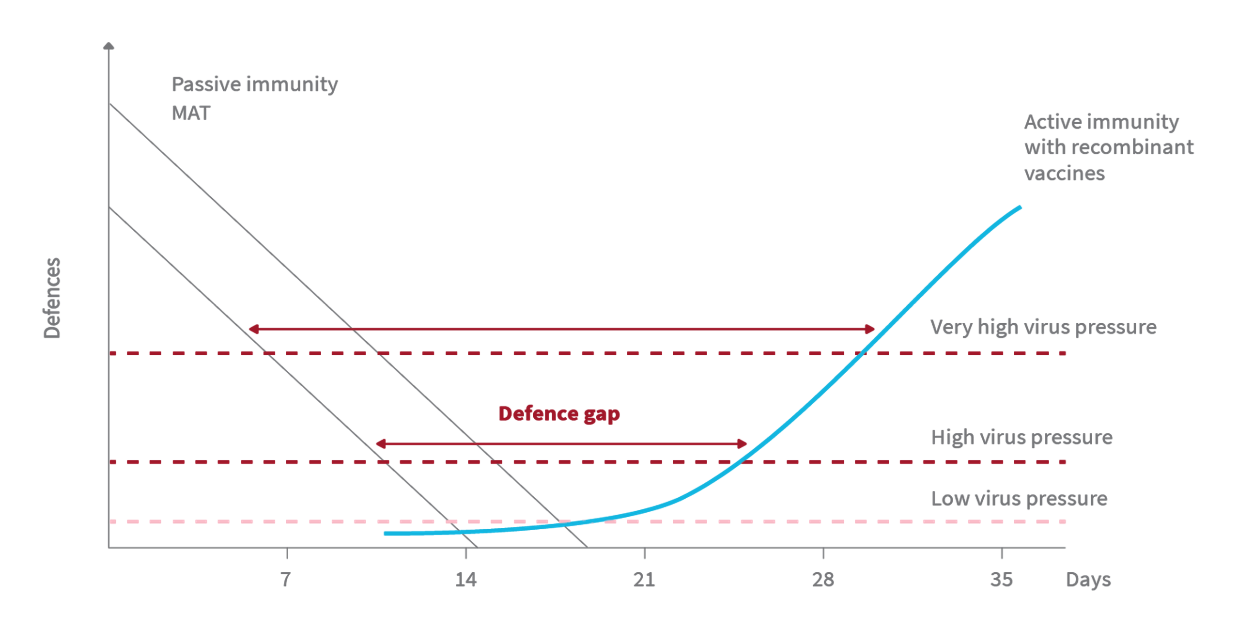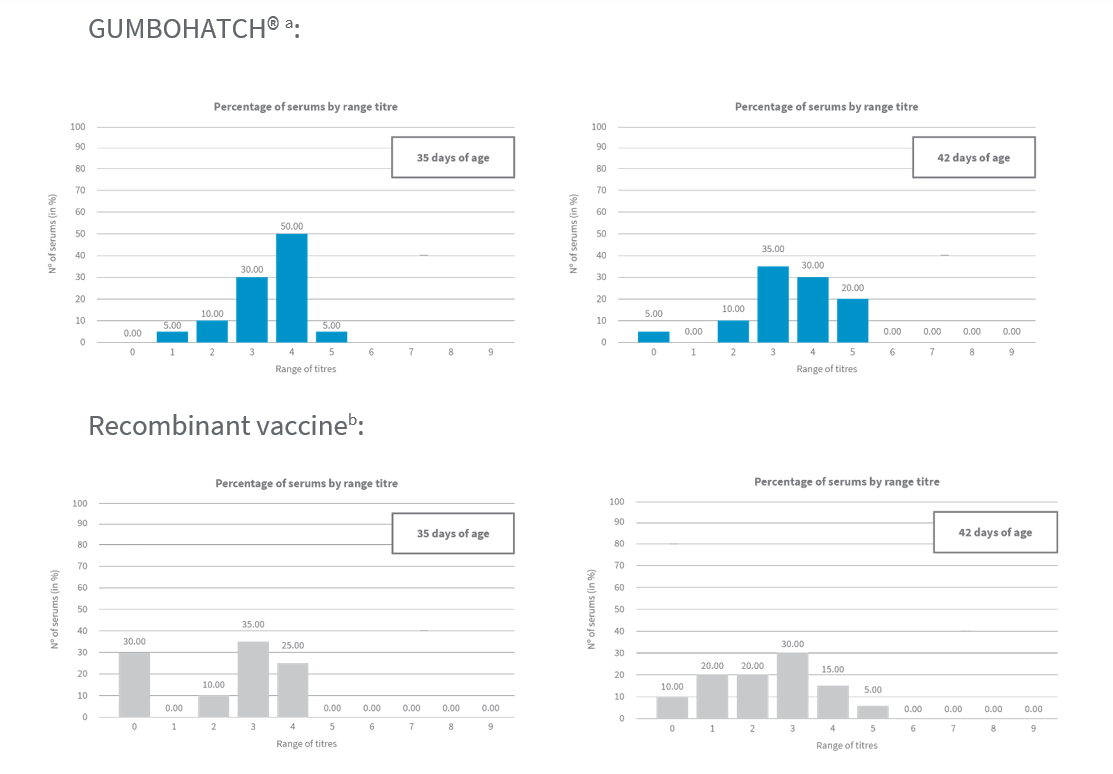



Benefits of a new immune complex vaccine concept in the European Gumboro situation
Gumboro disease has been present in Europe since the 1980s. Although the situation nowadays is quite stable in most areas thanks to intensive vaccination programmes, clinical disease is still being detected in some countries1, suggesting that the threat of the disease is still there and we cannot lower our guard.
In addition, several publications2 have been warning about the circulation of new vvIBDV strains since late 2018. There is no clear understanding of the impact of these new vvIBDV strains on the animals, but it has been suggested that they are involved in subclinical Gumboro disease. Furthermore, these new strains have been detected with the Diagnos GUMBOCHECK service in the United Kingdom, the Netherlands, Belgium and France.
GUMBOHATCH® is a new immune complex vaccine against Infectious bursal disease (IBD) developed by HIPRA. This new immune complex vaccine has introduced a different formulation (IgY of egg origin) and control parameters (free IgY detection and neutralisation control) to guarantee complete coating of the IBDV vaccine virus at the time of inoculation.
All these new improvements have resulted in a new concept of immune complex vaccine, which ensures the maintenance of maximum potency of the vaccine and consistent results in the field, whilst avoiding the risk of immunosuppression.
What are the benefits of a vaccine like GUMBOHATCH® in the current European Gumboro situation?
1. Earlier onset and more complete protection
One of the strategic points in the fight against Gumboro disease is to ensure full coverage of protection of the birds during the susceptible period, which normally lasts from 2 until 6 weeks of age.
During the first 2 -3 weeks of life of the chick, protection should be obtained through the passive immunity given by the maternally derived antibodies (MDAs), as no vaccination programme in the chicks will successfully cover this period. From 3 weeks of age onwards, protection should be provided by direct vaccination of the chick (active immunity). This period between the decline in passive immunity and the onset of active immunity must be as short as possible in order to avoid the feared immunity/defence gap.

Immune complex vaccines can provide the so-called “intelligent vaccination against IBDV” by adapting the onset of immunity to the protective needs of each individual chick, thereby decreasing the possibility of the immunity gap that can occur when other types of vaccine are used. To achieve this effect, it will be important for the vaccine virus to reach the bursa of Fabricius and start multiplying as soon as the MDAs are getting low.
GUMBOHATCH®, with its innovative formula that guarantees the maintenance of maximum vaccine potency even in the presence of high MDAs, has been shown to be able to reach the bursa sooner and to lead to an earlier onset of protection compared with alternative vaccines against IBDV (immune complex, recombinant, live attenuated).
Comparison with other immune complex (IC) vaccines in broilers (sc vaccination, France)

GUMBOHATCH® showed earlier vaccine replication and higher ELISA titres on the all days of testing.
Comparison with drinking water live attenuated vaccines in broilers (intermediate plus at day 15 vs in-ovo GUMBOHATCH®, Belgium):

GUMBOHATCH® showed higher ELISA titres on all the days of testing (even with higher initial MDAs) without the need to calculate the best day for vaccination.

GUMBOHATCH® showed better competitive exclusion protection on all the days of testing.
2. Better economic impact
Vaccines can reduce productivity losses due to illness and mortality, saving money in potential treatments and contributing to economic growth. Therefore, vaccines should be considered to be an economic investment, since they often have a greater economic impact than many other interventions.
Subclinical Gumboro disease, the most frequent scenario in Europe, is not always detected, but it is well documented that it can have an impact on flock performance with a slight increase in condemnations and an increase in FCR.
GUMBOHATCH® has already been shown to have a better economic impact compared to other vaccines in this European situation where the effect of Gumboro disease is not always clear.
Comparison of the cost per kg of meat versus another immune complex vaccine in broilers (in-ovo vaccination, Spain):

Data calculated from 56 batches reared from August-September 2020.bData calculated from 39 batches reared from August-September 2020.
GUMBOHATCH® showed a better economic impact with a decrease in the variable costs of 0.0107 €/kg of meat produced in a company with no detected circulation of Gumboro virus.
3. Safe protection/No immunosuppression
Previous experimental studies indicated that live IBD vaccination may induce transient immunosuppression, leading to suboptimal vaccine responses and therefore insufficient protection against other pathogens3.
GUMBOHATCH® has revolutionised the way of formulating and controlling immune complex vaccines to ensure the complete neutralisation of the live attenuated virus at the time of inoculation (in-ovo or subcutaneous). This complete neutralisation avoids the possibility of a too early replication of the vaccine virus in a developing bursa which could lead to the feared immunosuppressive effect4.
Comparative effect on bronchitis serology in slow-growing broilers vaccinated with GUMBOHATCH® or a recombinant vaccine (sc vaccination, Spain):

a,b Sample of 20 animals from a batch of 8,300 slow-growing broilers reared from December-February 2021.
The birds vaccinated with GUMBOHATCH® showed a better performance on the development of humoral immunity against bronchitis.
Thanks to all these benefits and much more, GUMBOHATCH® is a key tool in the control and prevention of Gumboro disease.
Contact your local HIPRA representative to discover what is behind this new immune complex vaccine concept against IBD!
| References | ||||
|---|---|---|---|---|
| 1 Gómez et al., 2018. Prospects of Plant-Based Vaccines in Veterinary Medicine. J. MacDonald (ed.):168-187. | ||||
| 2 Monitoring Diergezonheid 2018:117-120. | ||||
| 3 Boudaoud, A. and Alloui, N. Rev Sci Tech. 2008 Dec; 27(3):793-802. | ||||
| 4 https://www.ema.europa.eu/en/documents/product-information/gumbohatch-epar-product-information_en.pdf | ||||









